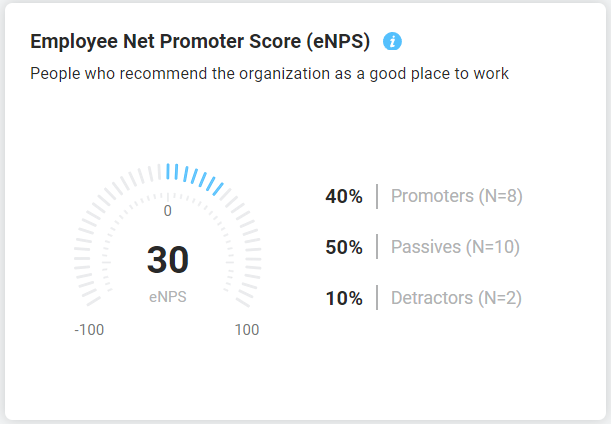Employee Net Promoter Score (eNPS)
eNPS is a way of measuring how your employees feel about your company and if they would recommend your company as a good place to work.
-
"I would recommend this organization as a good place to work” (1-5 scale)
-
“How likely would you be to recommend the organization as a good place to work?” (1-10 scale)
If using the engagement template, the 5-point scale eNPS question is already included in your survey. You will want to keep the 5-point eNPS question as it is also part of the engagement index calculation. If you swap the 5-point eNPS item for the 10-point eNPS item, you will not receive an engagement score.

How is eNPS calculated?
Most customer-based NPS research uses a 10-point scale. However, this type of scale is less user friendly for online surveys and mobile devices. People Element recommends using the 5-point Likert scale eNPS question from the Culture category to keep the scale consistent throughout your survey. A 5-point Likert scale provides a universal method for collecting data and is the most frequently used psychometric tool in employee surveys making it easy for people to respond (reducing cognitive load) and providing good reliability and validity.
-
Promoters are your most positive, satisfied, and motivated employees (Scored 5 or 9-10)
-
Passives are neutral. May be satisfied but are not fully committed (Scored 4 or 7-8)
-
Detractors won’t recommend your organization and may be unhappy or actively disengaged (Scored 1-3 or 1-6)
What is a Good eNPS?
The most important guide is your own historical comparison. A good eNPS is a score that is higher than your last. You should also recognize that your industry and culture play a role in determining what is "good".
A score above 0 means you have more happy employees advocating for the company compared to unhappy employees who may have a negative impact on your employer brand.
-
Above 0 is good
-
Above 30 is very good
-
Above 50 is excellent
-
Above 80 is best in class
Why use eNPS in an Exit survey?
Using eNPS in an exit survey gives you valuable insights into how satisfied departing employees are with their overall experience at your company and whether they would recommend it as a place to work. This metric helps you understand trends and issues within the organization, especially over time. It's important to identify if there are specific areas or groups from which detractors are emerging.
Remember, even if some employees express willingness to return in the future, their current departure indicates underlying reasons. Typically, eNPS scores are lower for exits compared to current employees, but monitoring this metric over time and across different groups provides valuable information.
![people element logooo.png]](https://20709424.hs-sites.com/hs-fs/hubfs/people%20element%20logooo.png?height=50&name=people%20element%20logooo.png)